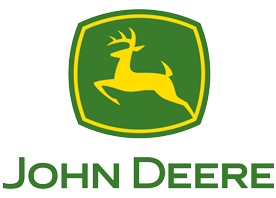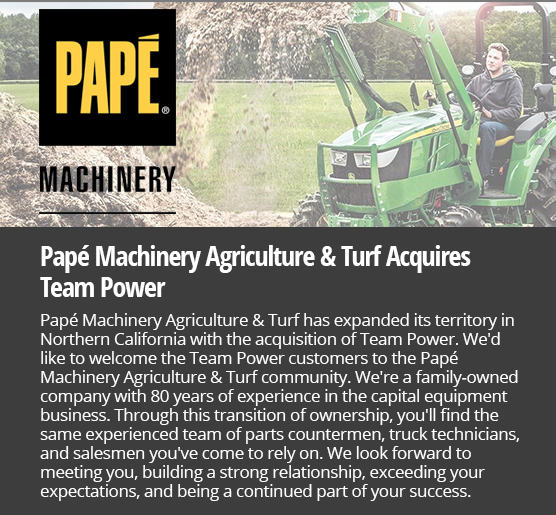
1415D Draper Platforms
- John Deere
- Windrowers
Find Your Nearest Location
Key Features & Specs
- Uninterrupted crop flow with C-shaped cutterbar
- Handle all crop conditions with strong, positive-feeding reel
- Excellent visibility to cutterbar and belt
- Provides a uniform cut with ground-following gauge wheels

- + Expand All
- - Close All
-
Cutterbar and frame profile gives uninterrupted crop flow
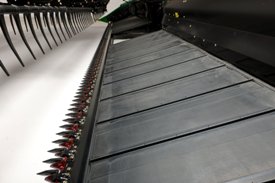 C-shaped cutterbar profile
C-shaped cutterbar profile

The C-shaped cutterbar profile provides:
- Smooth crop flow
- Superior draper-to-cutterbar seal
- Reduced amount of material under belts
- Minimized crop loss in shatter-prone crops
-
Strong, positive-feeding reel handles all crop conditions
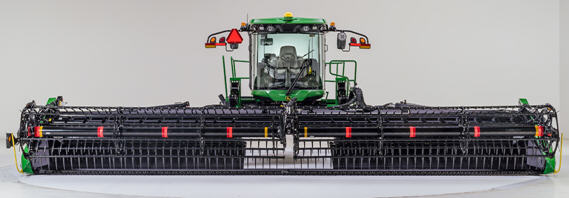 1435D split-span reel with plastic fingers
1435D split-span reel with plastic fingers
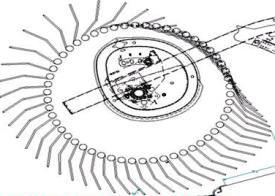 Cam reel tooth action
Cam reel tooth action
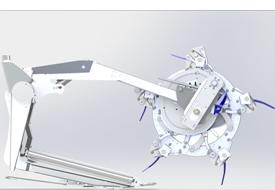 Reel in full forward position
Reel in full forward position
The cam real design of the 1400D Series Draper Platform features:
- 165-cm (65-in.) diameter
- Heavy-duty plastic or steel fingers
- Tooth position control
- Smoother and quieter operation at higher reel speeds
- Less wear on reel drive components
- Less shattering of the crop
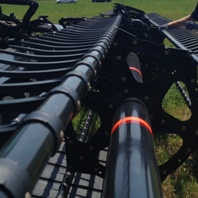 Hourglass-shaped reel
Hourglass-shaped reel
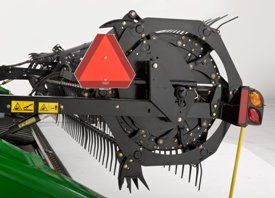 Reel end fingers
Reel end fingers
The hourglass-shaped reel has:
- End positioned closer to the cutterbar to provide smooth feeding
- Adjustable bolt position to change distance of reel to cutterbar
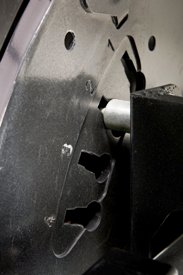 Adjustable cam positions
Adjustable cam positions

Plastic fingers:
- Standard from the factory on all 1400D Series Platforms
- Recommended for all crop conditions
- Lighter weight and easy to replace
Steel fingers:
- Only available through Parts
- Recommended for heavy forage crop
- Longer life
Optional end fingers improve feeding aggressiveness in difficult feeding and cutting conditions with down and tangled crop.
All 10.7-m (35-ft), 12.2-m (40-ft), and 13.7-m (45-ft) platforms come standard with tine tube stiffener kits to handle heavy crop conditions and improve the life of the platform.
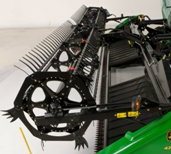 Plastic tine split reel with end feed fingers
Plastic tine split reel with end feed fingers

Single span reel:
- 6-m (15-ft), 6.1-m (20-ft), 7.6-m (25-ft), 9.1-m (30-ft), and 10.6-m (35-ft) sizes
- Less weight
- Better center visibility
- Good option for canola and small grains harvesting
Double span reel:
- 6-m (35-ft), 12.2-m (40-ft), and 13.7-m (45-ft) sizes
- Better feeding in heavy, wet, or down crop
- Better control of the reel height for more consistent feeding
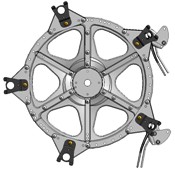 Five-bat reel
Five-bat reel
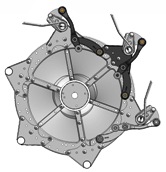 Six-bat reel
Six-bat reel
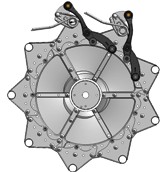 Nine-bat reel
Nine-bat reel
The reel is available in five-, six- or nine-bat configurations:
- Six- to nine-bat conversion is available with field installation
- Recommended for heavy conditions such as silage or grass seed crops
-
Excellent visibility to cutterbar and belt
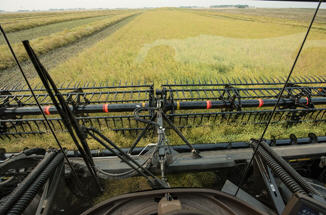 Cutterbar visibility
Cutterbar visibility
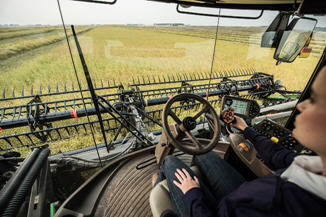 Right-side visibility
Right-side visibility
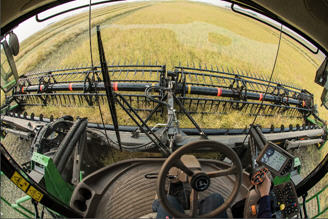 Left-side visibility
Left-side visibility
The cutterbar design provides excellent visibility across the full range of tilt:
- Cutterbar and belt can be easily seen from the cab even with the optional top-crop conveying auger installed
- Cutterbar can be tilted from the cab mechanically or hydraulically depending on the windrower option chosen
- Change cutterbar angle with varying crop and field conditions for best cut height and crop flow
-
Gauge wheels provide ground following for uniform cut
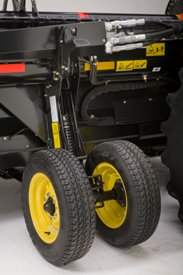 Dual gauge wheel option
Dual gauge wheel option

1400D Series Draper Platforms offer optional dual gauge wheels with spring suspension:
- 1-cm (15-in.)
- Excellent ground following and flotation in all conditions
- Fine adjust the float on the go from the cab for high-speed harvesting and stable flotation
- Available as part of the integrated slow-speed transport system option
-
Hydraulic deck shift gives larger windrows for more efficient harvesting
John Deere 1425D, 1430D, and 1435D Drapers can windrow out of the center, right, or left ends of the draper with the press of a button using the hydraulic shift option.
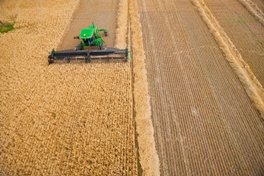 Double windrow using deck shift
Double windrow using deck shift
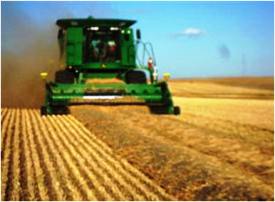 Double windrow being combined
Double windrow being combined
Hydraulic deck shift option:
- Larger windrows to match combine or self-propelled forage harvester
- Match narrower-width drapers with higher-capacity harvesting
- Place higher-density windrows in front of harvesters when yields are low
- Discharge two windrows side by side for uniform combine or forage harvester feeding
- Move chain stop to change center belt opening quickly and easily for different crop types and density (see operator’s manual for more information)
- Discharge crop to the outside of the headland to prevent running over the windrow while cutting the rest of the field
- Platform stays balanced with automatic fine-float adjustment when using deck shift
- Optional double draper drive bundle is recommended when using deck shift and harvesting silage or wet, heavy crops
- NOTE: The double draper drive option is not compatible with the 1425D Platform.
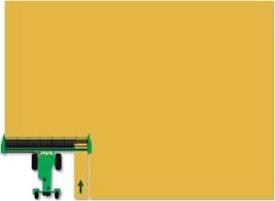 First pass - right discharge
First pass - right discharge
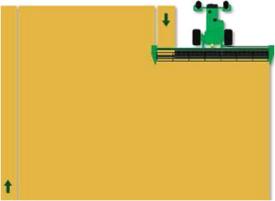 Second pass - right discharge
Second pass - right discharge
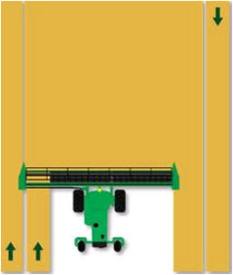 Third pass - left discharge
Third pass - left discharge

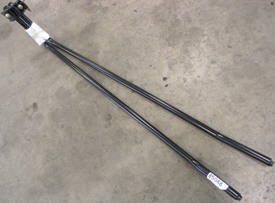 Swath forming rods
Swath forming rods

Optional left- and right-end swath deflector rods form a space between the windrow and uncut crop to have adequate clearance for the crop divider on the next pass.
-
Transport easily with integrated transport system
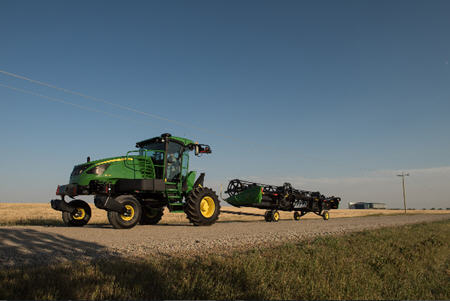 1400D integrated slow-speed transport system behind W170 Windrower
1400D integrated slow-speed transport system behind W170 Windrower

Slow-speed transport system:
- 1400D Drapers are towable only with the W170 Self-Propelled Windrower
- Transport is recommended behind a tractor with seven-pin electrical lighting outlet
- 1430D, 1435D, 1440D, and 1445D Drapers only
- Convert draper from field to transport in minutes with one person and without tools
- Dual front dolly wheel tires and two gauge wheel tires carry the weight of transport
It is a simple four-step process to switch from field to transport:
- Move right gauge wheels from field to transport
- Move left gauge wheels from field to transport
- Attach the tongue.
- Detach from the windrower.
Auxiliary top auger
| Type | Optional hydraulic drive |
Center opening / crop delivery
| Center opening width between belts | 1,540-1,770 mm 60.6-69.7 in. |
Cutterbar
| Knife drive | Hydraulic motor to belt to enclosed heavy-duty wobble box |
| Type | Dual knife |
| Cutterbar tilt | Standard hydraulic Optional mechanical (7.5 to 17.0 degree tilt) |
| Knife speed | 750-950 cycles/min 1,500-1,900 spm |
| Cut width (length) | 4.6 m 15 ft |
Dimensions
| Transport length, hitch extended | ---- |
| Transport width on wheel, less dividers | 2.5 m 8.1 ft |
| Overall operating depth | With crop dividers 2.7 m 8.7 ft |
| Platform length | 5 m 16.3 ft |
| Transport width, field position | 5 m 16.3 ft |
Draper and decks
| Speed control | Hydraulic from cab |
| Belt width | Wide rubber skim-coated 710-ml (24-oz) drapers 1,067 mm 41.6 in. |
| Operating speed | 0-225 m/min 0-742 fpm |
Header height sensing
| Header height sensing on the ground | Float springs on traction unit |
| Header height sensing off the ground | Return to cut height standard Gauge wheels optional |
Key Specs
| Cutterbar - Type | Dual knife |
| Reel type | Pick up cam 4 position adjustable release |
| Fingers | HD Plastic |
| Transport width on wheel, less dividers | 2.5 m 8.1 ft |
| Transport width, field position | 5 m 16.3 ft |
| Cut width (length) | 4.6 m 15 ft |
| Overall operating depth | With crop dividers 2.7 m 8.7 ft |
| Platform length | 5 m 16.3 ft |
| Belt width | Wide rubber skim-coated 710-ml (24-oz) drapers 1,067 mm 41.6 in. |
Reel
| Speed control | Hydraulic with header index |
| Operating speeds | 0-85 rpm |
| Height control | Hydraulic |
| Reel type | Pick up cam 4 position adjustable release |
| Fingers | HD Plastic |
| Reel lift | Hydraulic |
| Reel fore and aft | Hydraulic |
| Diameter | 1,650 mm 65 in. |
| Number of bats | 6 bats standard 9 bats optional (single span, capped ends) |
Weight
| Approximate weight (base platform with reel) | 1,362 kg 3,000 lb |


